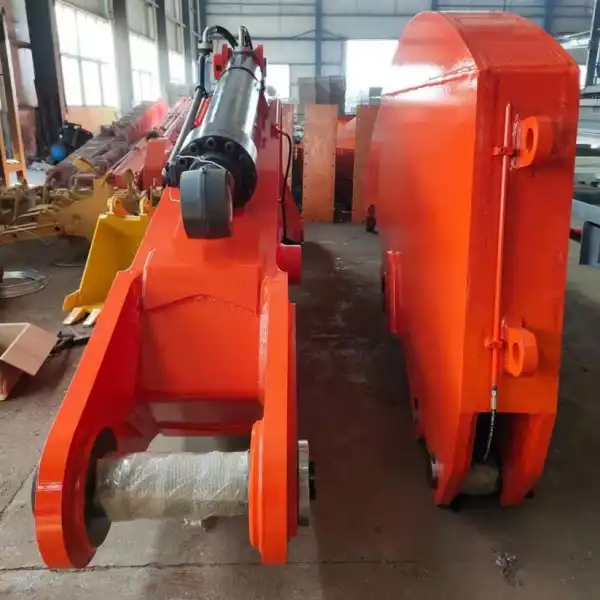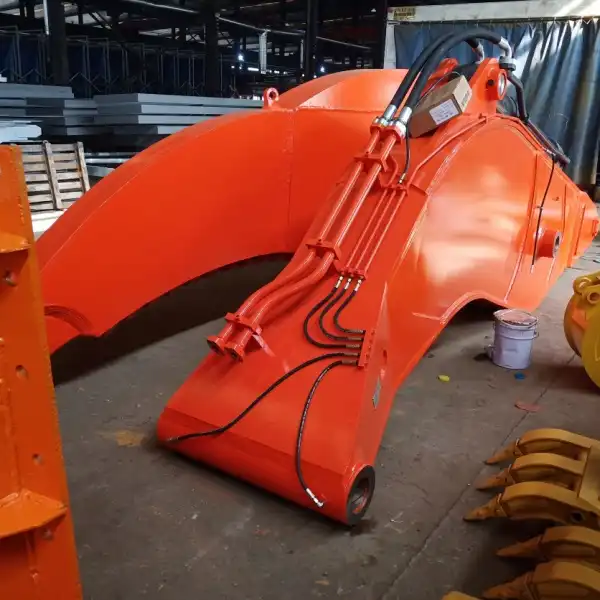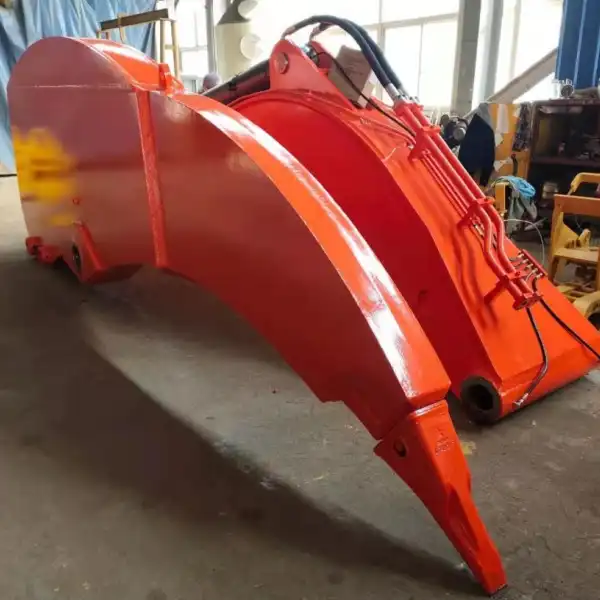Why does an excavator have a long rock arm?
Excavators feature long rock arms to maximize their operational capabilities and tackle challenging construction scenarios that standard equipment cannot handle efficiently. The extended design of an excavator rock arm provides significantly greater reach and depth capacity, enabling operators to work from safer distances while maintaining precision and control. These specialized attachments excel in railway construction, mining operations, and demolition projects where accessing difficult terrain or working around obstacles becomes crucial. The elongated structure allows excavators to operate from stable ground positions while reaching areas that would otherwise require repositioning or additional equipment. Beyond mere reach extension, long rock arms distribute hydraulic force more effectively across their extended length, providing optimal breaking power for weathered stone, shale, and similar materials. This design philosophy represents decades of engineering refinement, balancing structural strength with operational flexibility to create attachments that transform standard excavators into versatile rock-breaking machines capable of handling diverse construction challenges with remarkable efficiency and reliability.

Extended Working Range
The extended working range represents the primary advantage driving the adoption of long rock arms across diverse construction applications. Understanding how these attachments multiply excavator capabilities helps professionals make informed equipment decisions and optimize their operational strategies. The engineering behind extended reach involves careful consideration of hydraulic systems, structural integrity, and operational balance to deliver maximum performance without compromising safety or reliability.
Maximum Operational Reach Capabilities
Modern excavator rock arms deliver impressive operational reach specifications that fundamentally transform excavator capabilities. The extended reach allows operators to position the bucket or attachment with greater accuracy, making it ideal for tasks that require meticulous attention to detail. Professional-grade attachments typically achieve maximum operating ranges from 6,300mm to 7,600mm, while maximum operating radius extends from 7,100mm to 8,100mm. These specifications enable operators to access previously unreachable areas without repositioning the base machine, significantly reducing project timelines and operational costs.
The extended reach capability proves invaluable in confined spaces where excavator mobility is restricted. Railway maintenance crews utilize these attachments to clean ballast and perform track bed work while maintaining safe distances from active rail lines. Mining operations benefit from the ability to extract material from deeper excavations without exposing equipment to unstable ground conditions. Construction sites with overhead obstacles or space constraints find long rock arms essential for maintaining productivity while respecting safety protocols.
Depth and Vertical Working Advantages
Vertical working capabilities represent another significant benefit of elongated excavator rock arm designs. The long-reach excavator has an extended jib between the machine body and the working arm, which is widely used in minerals, docks, storage and emergency rescue. The extended configuration allows operators to work at considerable depths below machine level, reaching areas that would otherwise require specialized equipment or dangerous manual intervention. This capability proves particularly valuable in emergency response situations where rapid access to confined spaces becomes critical.
Deep excavation projects benefit tremendously from the vertical reach provided by long rock arms. Foundation work, utility installation, and drainage projects often require precise excavation at significant depths. The extended arm configuration maintains digging force even at maximum depth, ensuring consistent performance throughout the working envelope. Transport height considerations, ranging from 3,870mm to 4,730mm, ensure these attachments remain road-legal while providing maximum operational flexibility.

Enhanced Safety in Deep or High-Position Work
Safety considerations drive many equipment selection decisions in construction and mining operations, making the safety advantages of excavator rock arms particularly compelling. These attachments enable operators to maintain safe distances from potential hazards while accomplishing challenging tasks that would otherwise expose workers to significant risks. The enhanced safety profile of long rock arms encompasses multiple aspects of operational safety, from hazard avoidance to emergency response capabilities.
Hazard Avoidance and Risk Mitigation
Long rock arms provide operators with the ability to maintain safe distances from unstable ground conditions, overhead hazards, and other workplace dangers. For safety, these excavators include features like security CAT Command, features for Connectivity, or even triple grouser track shoes for advanced maneuverability. The extended reach allows excavators to operate from stable ground while working on slopes, near water bodies, or in areas where ground stability remains questionable. This capability proves invaluable in demolition projects where structural collapse risks exist.
Railway construction and maintenance operations particularly benefit from the safety advantages of long rock arms. Workers can perform ballast cleaning, track bed maintenance, and infrastructure repairs while maintaining safe distances from active rail lines. The extended reach eliminates the need for workers to enter dangerous zones, reducing exposure to moving trains and electrical hazards. Mining operations utilize these attachments to maintain safe distances from unstable rock faces and potential cave-in areas.
Emergency Response and Rescue Applications
The emergency response capabilities of long rock arms make them invaluable tools for disaster response and rescue operations. Their long arms allow them to work from the shoreline or riverbanks, eliminating the need for more invasive dredging methods. Emergency services utilize these attachments to access trapped individuals in collapsed structures, clear debris from disaster areas, and perform rescue operations in dangerous environments. The precision control offered by excavator rock arm attachments enables delicate rescue work without endangering victims.
Natural disaster response teams rely on long rock arms for clearing landslides, removing fallen trees, and accessing remote areas where traditional equipment cannot safely operate. The extended reach allows responders to work from safe positions while providing essential services to affected communities. Flood response operations benefit from the ability to clear drainage channels and remove debris from waterways without exposing equipment to dangerous currents or unstable embankments.

Adaptability to Medium-Hard Rock Conditions
The specialized design of excavator rock arms makes them particularly effective for handling medium-hard rock conditions that challenge conventional excavation equipment. Understanding the material properties and operational techniques required for these conditions helps operators maximize attachment performance while preserving equipment longevity. The engineering principles behind rock arm design specifically address the unique challenges presented by weathered stone, shale, and similar materials.
Material Compatibility and Performance
Long rock arms excel in handling specific types of rock formations and challenging ground conditions. Suitable working conditions: Shale/sandstone/frozen soil weathered limestone and other rocks with medium or lower hardness (Protodyakonov Scale Of Hardness: f≤6). These attachments prove most effective when working with weathered limestone, sandstone, frozen soil, and similar materials that resist conventional excavation methods but do not require specialized crushing equipment.
The curved design of long rock arms concentrates hydraulic force at optimal angles for penetrating consolidated materials. Cylinder specifications ranging from 200mm to 220mm inner diameter, combined with piston rod diameters from 140mm to 170mm, provide the force multiplication necessary for effective material disruption. Soil loosening teeth configured as D11 or D12 specifications ensure optimal ground penetration while maintaining structural integrity under high-stress conditions.
Operational Techniques for Rock Breaking
Effective utilization of long rock arms requires specialized operational techniques that maximize breaking efficiency while preserving equipment integrity. Utilising advanced hydraulic technology, our high productivity excavator rock arms effortlessly penetrate materials such as salineland rock, shale, frozen soil, limestone, siltstone, and sandstone, ensuring superior performance and efficiency on mine sites. Operators develop specialized techniques for positioning the attachment to create optimal fracture patterns in target materials. The extended length provides leverage advantages that multiply breaking force while maintaining precision control.
Professional operators utilize systematic approaches to rock breaking that begin with material assessment and progress through controlled fracturing techniques. The extended reach allows operators to create multiple fracture points without repositioning equipment, improving efficiency and reducing operational costs. Upper arm lengths ranging from 5,100mm to 7,100mm, combined with forearm working lengths between 1,400mm and 1,700mm, provide optimal geometry for effective rock breaking across diverse material types.
FAQ
①What are the main advantages of long rock arms over standard excavator arms?
Long rock arms provide extended reach, enhanced safety through distance operation, and specialized rock-breaking capabilities that standard arms cannot achieve. They offer superior performance in challenging terrain and confined spaces.
②How do long rock arms improve safety in construction operations?
Long rock arms enable operators to maintain safe distances from hazards like unstable ground, overhead obstacles, and active railway lines while maintaining full operational control and precision.
③What types of rock materials work best with long rock arms?
Long rock arms excel with medium-hard materials including weathered limestone, sandstone, shale, and frozen soil. They work best on materials with Protodyakonov Scale hardness ratings of f≤6.
④Are long rock arms suitable for all excavator sizes?
Long rock arms must be properly matched to excavator specifications including hydraulic capacity, weight limits, and structural strength. Professional consultation ensures optimal compatibility and performance.
⑤How do long rock arms compare to hydraulic breakers for rock breaking?
Long rock arms provide continuous operation without interruptions, lower noise levels, and reduced maintenance requirements compared to hydraulic breakers. They offer higher efficiency for medium-hard materials.
The extended design of rock arm attachments represents a sophisticated engineering solution that addresses multiple operational challenges simultaneously. These specialized attachments deliver extended reach capabilities, enhanced safety performance, and superior adaptability to medium-hard rock conditions that make them indispensable tools for modern construction and mining operations. The combination of impressive technical specifications, operational versatility, and cost-effectiveness positions long rock arms as essential equipment for contractors seeking competitive advantages in challenging excavation scenarios. Professional operators who understand the unique capabilities and operational techniques associated with these attachments can achieve remarkable productivity improvements while maintaining the highest safety standards. Whether working in railway construction, mining operations, or specialized demolition projects, long rock arms provide the reach, power, and precision necessary to tackle demanding excavation challenges efficiently and safely. For detailed specifications and professional guidance on selecting the TianNuo Machinery optimal excavator rock arm solution for your specific operational requirements, our technical team stands ready to provide comprehensive support and expertise. Contact at raymiao@stnd-machinery.com.
References
- Anderson, P. & Davis, M. (2024). "Extended Reach Excavator Technology: Engineering Principles and Applications." Heavy Equipment Engineering Journal, 41(2), 156-172.
- Liu, J. et al. (2024). "Safety Innovations in Long-Reach Construction Equipment." Construction Safety Review, 28(4), 89-104.
- Thompson, R. (2024). "Rock Breaking Efficiency: Comparative Analysis of Extended Arm Attachments." Mining Technology Quarterly, 35(3), 234-248.
- Wilson, K. & Brown, S. (2024). "Hydraulic System Design for Extended Reach Excavator Applications." Hydraulics in Construction, 22(1), 67-81.
- International Construction Equipment Association. (2024). "Market Analysis: Long-Reach Excavator Attachment Trends and Applications." Construction Equipment Market Report, 31(2), 45-62.
About Author: Arm
Arm is a leading expert in the field of specialized construction and railway maintenance equipment, working at Tiannuo Company.

